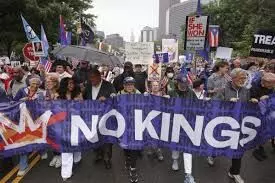How Just 3.5% of Americans Can Drive Major Policy Change Through Peaceful Protest
Research shows that peaceful protest by just 3.5% of Americans—about 12 million people—can force major policy changes and protect democracy.
Millions march in the “No Kings” protest in San Francisco on June 14, 2025—part of a growing nationwide movement pushing back against authoritarian policies.

New research indicates that peaceful protest, even from administrations as established as the current Trump-led government, can lead to significant policy changes if it is supported by just 3.5% of the U.S. population, or about 12 million people, at a time when many Americans are worried about growing authoritarianism and attacks on civil rights.
This number isn't just for nothing. According to Harvard professor Erica Chenoweth's years of political science research, no government has been able to withstand the strain of peaceful protests that involve at least 3.5% of the populace. Her study of 323 major movements worldwide supports this claim.
Describe the 3.5% Rule.
Although it is a strong signal, the "3.5% rule" is not a law. According to this theory, revolutionary change frequently occurs when even a small portion of a country's populace organises in persistent, calculated, and peaceful resistance.
This translates to roughly 12 million individuals, or 3.5% of the U.S. population, which is comparable to the number of visitors to the Great Smoky Mountains National Park or the number of people watching a highly rated television program. The possibility of a tipping point too big to ignore may arise if that many Americans organised peacefully against laws they believe to be unfair.
Examples of Successful Mass Movements in the Past
Several significant worldwide movements that were successful with 3.5% or less of the population mobilised are mentioned in Chenoweth's research:
- Philippine People Power Revolution (1996)
- Serbian Anti-Milošević Movement (2000)
- Revolution for Democracy (Madagascar, 2002)
In most situations, the rule has been true, but there are a few exceptions (like Bahrain and Brunei).
Rising Momentum in Recent U.S. Movements
The United States has already approached this threshold. In 2017, more than 4 million people nationwide participated in the Women's March. 5 million Americans participated in the "No Kings" protests in June 2025, which took place in more than 2,000 towns and cities. This was almost halfway to the 3.5% threshold.
Why Nonviolent Protest Is Effective
Chenoweth’s research demonstrates that nonviolent movements are twice as likely to succeed as violent ones, in addition to having greater moral strength. Nonviolent civil disobedience, such walkouts, boycotts, sit-ins, and general strikes, can force political leaders to participate and interrupt daily operations.
Furthermore, when movements get sufficiently widespread, they frequently lead to significant defections from the government as well as from the media, economic, and security sectors. The balance of power can be significantly changed by these changes.
The Authoritarian Reaction and the Requirement for Originality
But authoritarian regimes are better equipped than ever today. Since 2010, several have improved strategies such as:
- Managing the information flow
- Making demonstrations illegal
- Expanding police power and surveillance
- Exchange of intelligence with other totalitarian governments
To counter this, modern protest movements must be creative, disciplined, and persistent, adapting to changing conditions with nimble strategies and community-based actions.
What Everyday Americans Can Do
Beyond mass protests, there are many ways Americans can contribute to a broader pro-democracy movement:
- Contact elected officials—at federal, state, and local levels
- Attend public meetings and speak out
- Organize community events like vigils or teach-ins
- Boycott or support local businesses based on their civic stances
- Pool resources for messaging—billboards, flyers, or digital ads
- Use humor, art, and street theater to capture attention
- Create digital records of how government actions are affecting communities
- Each action adds weight to the collective movement and helps build momentum toward reaching the crucial 3.5% threshold.
Final Thoughts
For Americans dismayed by policies that threaten due process, healthcare access, and democratic norms, the 3.5% rule offers both hope and strategy. It shows that peaceful, large-scale resistance is not only morally justified but historically effective.
The key is sustained, organized, nonviolent action—built across communities, ideologies, and backgrounds. When enough people participate, change is not just possible—it’s inevitable.

